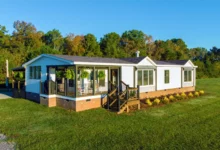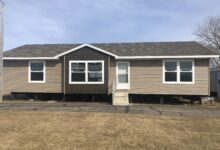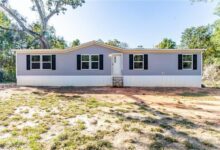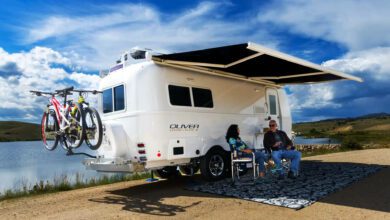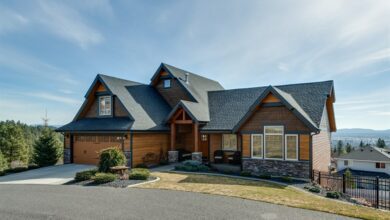Find the Perfect Van Camper for Sale Near You
Van Camper for Sale Near Me – Are you dreaming of hitting the open road in a cozy and versatile van camper? Look no further! In this comprehensive guide, we’ll walk you through everything you need to know about finding the perfect van camper for sale near you. Whether you’re a weekend warrior or a full-time adventurer, we’ve got you covered.
From choosing the right type of van camper to understanding the key features and considerations, we’ll provide you with all the information you need to make an informed decision. So, let’s dive in and start your journey to van life!
Types of Van Campers
When it comes to van campers, there is a wide range of options available to suit different travel styles and preferences. Let’s explore the various types of van campers you can choose from:
1. Class B Motorhomes
Class B motorhomes, also known as camper vans, are compact and highly maneuverable. They are built on a van chassis and offer the convenience of a smaller vehicle with the added features of a motorhome. Class B motorhomes typically include sleeping quarters, a small kitchenette, and a bathroom.
2. Conversion Vans
Conversion vans are often customized by individuals or companies to serve as campers. These vans may have raised roofs, added windows, and interior modifications to provide comfortable living and sleeping spaces. Conversion vans offer flexibility and can be customized to meet specific needs.
3. Pop-Top Campers
Pop-top campers are vans with a retractable roof that can be raised when parked, providing additional headroom and sleeping space. These campers are ideal for those who want extra space but still want the convenience of a compact van when driving.
4. High-Top Campers
High-top campers have a raised roof that extends the full height of the van. This design allows for standing room inside the camper and provides ample space for storage and additional sleeping areas. High-top campers are popular among those who prioritize comfort and spaciousness.
5. Slide-In Campers
Slide-in campers, also known as truck campers, are designed to fit into the bed of a pickup truck. These campers offer the convenience of a detachable living space that can be easily removed when not in use. Slide-in campers are a great option for those who already own a pickup truck and want the flexibility to use it for other purposes.
Budgeting for Your Van Camper
Before diving into the world of van campers, it’s essential to establish a budget to ensure you make a financially sound decision. Here are some key factors to consider when budgeting for your van camper:
1. Purchase Price
The purchase price of a van camper can vary significantly depending on factors such as the age, condition, and features of the vehicle. Set a budget range based on your financial situation and research the market to get an idea of the prices for different types of van campers.
2. Insurance
Don’t forget to include insurance costs in your budget. Van campers typically require specialized insurance coverage, so be sure to obtain quotes from different insurance providers to find the best coverage at the most affordable price.
3. Maintenance and Repairs
Like any vehicle, van campers require regular maintenance and occasional repairs. Factor in the costs of routine servicing, oil changes, tire rotations, and other maintenance tasks. It’s also wise to set aside some funds for unexpected repairs that may arise.
4. Upgrades and Customization
If you plan on customizing or upgrading your van camper, allocate a portion of your budget for these additions. Whether it’s installing solar panels, upgrading the interior, or adding off-grid capabilities, having a budget for modifications will ensure you can create your dream camper.
5. Fuel and Travel Expenses
Consider the cost of fuel and other travel expenses when budgeting for your van camper adventures. Calculate an estimate based on your planned travel distance and the fuel efficiency of your chosen van camper model. Don’t forget to account for campground fees, food, and other incidentals.
Researching Local Dealerships
When it comes to purchasing a van camper, finding a reputable dealership is crucial. Here’s how you can research and select the best dealership near you:
1. Online Reviews
Start your research by reading online reviews of local dealerships. Websites like Yelp, Google Reviews, and RV forums can provide insights into the experiences of previous customers. Look for consistently positive reviews and take note of any recurring complaints or issues.
2. Visit Dealership Websites
Visit the websites of local dealerships to gather more information about the van campers they have for sale. Look for clear and detailed descriptions of the vehicles, as well as high-quality photos that allow you to assess the condition of the campers.
3. Compare Prices
Compare prices of van campers at different dealerships to ensure you get the best deal. Keep in mind that prices may vary depending on factors such as the age, condition, and features of the vehicle. Consider the overall value and condition of the camper rather than solely focusing on the price.
4. Check Dealer Reputation
Research the reputation of the dealerships you are considering. Look for any complaints or legal issues that may have been filed against them. A reputable dealership will have a history of satisfied customers and a commitment to customer service.
5. Visit the Dealership
Once you have narrowed down your options, visit the dealerships in person to get a firsthand experience. Talk to the sales staff, ask questions, and inspect the available van campers. Pay attention to the level of customer service and how knowledgeable and helpful the staff are.
Inspecting the Van Camper
Inspecting a van camper thoroughly is essential to ensure you’re making a wise investment. Here’s a checklist to follow when inspecting a van camper:
1. Exterior Inspection
Start by examining the exterior of the van camper. Look for any signs of damage, such as dents, scratches, or rust. Inspect the tires for wear and check for any leaks or damage to the roof or windows. Take note of the overall condition and cleanliness of the exterior.
2. Interior Inspection
Step inside the van camper and carefully inspect the interior. Check for any signs of water damage, such as stains or mold, especially near windows and the roof. Test all appliances and systems, including the stove, refrigerator, heating, and cooling systems. Pay attention to the condition of the upholstery, flooring, and cabinetry.
3. Mechanical Inspection
If possible, have a qualified mechanic inspect the mechanical components of the van camper. They can assess the engine, transmission, brakes, and other systems to ensure they are in good working order. This inspection can help identify any potential issues or necessary repairs.
4. Test Drive
Take the van camper for a test drive to evaluate its performance and drivability. Pay attention to how it handles on different road conditions and check for any unusual noises or vibrations. Test the brakes, accelerator, and steering to ensure they are responsive and smooth.
5. Documentation and History
Ask for any documentation related to the van camper, including maintenance records and the vehicle history report. These documents can provide valuable insights into the vehicle’s maintenance history, accident records, and ownership details.
Understanding Van Camper Features
Van campers come with various features and amenities to make your travels comfortable and enjoyable. Here are some key features to consider:
1. Sleeping Arrangements
Van campers offer different sleeping arrangements, such as foldable beds, bunk beds, or convertible seating areas. Consider the number of people who will be traveling with you and the desired level of comfort when choosing a van camper with suitable sleeping options.
2. Kitchen Facilities
Most van campers come equipped with a small kitchenette or galley area. Look for features like a stove, sink, refrigerator, and storage space for cookware and utensils. Consider your cooking preferences and the level of meal preparation you plan to do on the road.
3. Bathroom Options
Some van campers have built-in bathrooms with toilets, showers, and sinks, while others may have portable or outdoor shower options. Assess your needs for bathroom facilities and choose a van camper that offers the level of convenience and privacy you desire.
4. Storage Solutions
Storage space is crucial in a van camper, especially if you plan on longer trips or full-time van life. Look for ample storage compartments, cabinets, and closets to accommodate your belongings. Consider if you have specific gear or equipment that requires dedicated storage space.
5. Entertainment and Connectivity
Consider the availability of entertainment and connectivity options in the van camper. Lookfor features such as a built-in entertainment system with a TV or a sound system for music. Additionally, check if the van camper offers USB ports, electrical outlets, or Wi-Fi connectivity to keep you connected and entertained during your travels.
6. Climate Control
Climate control is essential for your comfort while on the road. Look for features such as air conditioning and heating systems to regulate the temperature inside the van camper. Consider if the camper offers insulation for colder climates or ventilation options for warm weather.
7. Off-Grid Capabilities
If you plan on camping in remote areas or boondocking, consider the off-grid capabilities of the van camper. Look for features such as solar panels, larger water tanks, and energy-efficient appliances that allow you to be self-sufficient without relying on external hookups.
8. Safety Features
Ensure that the van camper is equipped with essential safety features. Look for features such as airbags, anti-lock braking systems, rearview cameras, and smoke detectors. It’s also a good idea to check if the van camper meets safety standards and has any additional security features.
9. Accessibility and Mobility
If you have mobility concerns or specific accessibility needs, consider van campers that offer features such as wheelchair lifts, accessible bathrooms, and wider doorways. Choose a camper that accommodates your specific requirements to ensure a comfortable and hassle-free experience.
10. Exterior Additions
Some van campers offer additional exterior features that can enhance your camping experience. Look for options such as awnings, bike racks, roof racks, or storage compartments to add versatility and convenience to your outdoor adventures.
Test Driving a Van Camper
Test driving a van camper is crucial to assess its performance and ensure it meets your expectations. Here are some tips for a successful test drive:
1. Familiarize Yourself with the Controls
Before hitting the road, take the time to familiarize yourself with the controls and features of the van camper. Adjust the seat, mirrors, and steering wheel to ensure a comfortable driving position.
2. Assess Drivability
Pay attention to how the van camper handles on different road conditions. Test its acceleration, braking, and maneuverability. Note if it feels stable and responsive, and if there are any vibrations, noises, or handling issues.
3. Test Parking and Turning Radius
Practice parking and making tight turns to assess the van camper’s maneuverability. Consider if it meets your needs in terms of fitting into parking spaces, navigating narrow roads, or making U-turns.
4. Check Visibility
Ensure that you have good visibility from the driver’s seat. Check the positioning of mirrors and the size of blind spots. Consider if the van camper offers additional visibility features such as backup cameras or blind-spot monitoring systems.
5. Test Comfort and Ergonomics
Assess the comfort and ergonomics of the van camper while driving. Check if the seats provide adequate support and if the driving position feels natural. Consider if the controls and instruments are easy to reach and operate without causing discomfort or distraction.
6. Test Noise Levels
Pay attention to the noise levels inside the van camper while driving. Note if there are any excessive engine, wind, or road noises that may affect your comfort or enjoyment during long drives.
7. Try Various Road Conditions
Test the van camper on different road conditions such as highways, city streets, and bumpy roads. Note if it feels stable, absorbs shocks well, and provides a smooth ride. Consider how it handles hills, curves, and uneven surfaces.
8. Assess Parking and Backup Assistance
Practice parking and using any parking or backup assistance features the van camper may have. Test the effectiveness of features such as rearview cameras or parking sensors to ensure they provide the necessary assistance for safe maneuvering.
9. Evaluate Driver Visibility
Consider the overall driver visibility from the van camper. Assess if there are any blind spots or obstructed views that may impact your safety on the road. Ensure that you have a clear and unobstructed view of the surroundings.
10. Ask Questions and Take Notes
During the test drive, don’t hesitate to ask the seller or dealership representative any questions that arise. Take notes on your impressions, any concerns, or specific features that stood out to help you make an informed decision.
Financing Options
Van campers can be a significant investment, but there are various financing options available to help you make your dream a reality. Here are some financing options to consider:
1. Traditional Auto Loans
Consider applying for a traditional auto loan from a bank, credit union, or online lender. These loans typically offer competitive interest rates and fixed repayment terms. Shop around and compare loan offers to find the best terms and rates that fit your financial situation.
2. RV Loans
Some financial institutions specialize in RV loans specifically designed for motorhomes and campers. These loans may offer more favorable terms and flexibility tailored to the unique needs of RV owners. Research RV loan providers and compare their offers to secure the best financing option.
3. Personal Loans
If you have a good credit score and a strong financial profile, you may qualify for a personal loan. Personal loans can be used for various purposes, including purchasing a van camper. However, keep in mind that personal loans may have higher interest rates compared to specialized RV loans.
4. Manufacturer Financing
Some van camper manufacturers offer their own financing options or work with affiliated lenders. These financing options may come with special promotions or incentives, such as low-interest rates or extended warranty offers. Inquire with the manufacturer or dealership about their financing programs.
5. Leasing
Leasing a van camper is an alternative to purchasing. With a lease, you essentially rent the van camper for a specific period, typically a few years, and make monthly lease payments. Leasing allows for lower upfront costs and the ability to upgrade to a new model at the end of the lease term.
6. Consider Your Financial Situation
Before committing to any financing option, carefully evaluate your financial situation and consider factors such as your credit score, income stability, and monthly budget. Choose a financing option that aligns with your financial goals and ensures you can comfortably afford the monthly payments.
7. Get Pre-Approved
If you decide to pursue financing, it’s a good idea to get pre-approved before shopping for a van camper. Pre-approval gives you a clear understanding of your budget and allows you to negotiate with sellers confidently. It also simplifies the purchasing process as you already have a financing plan in place.
8. Read the Fine Print
Before signing any financing agreement, carefully read and understand the terms and conditions. Pay attention to interest rates, repayment schedules, any associated fees, and potential penalties for early repayment. Seek clarification on any points that are unclear or raise concerns.
9. Calculate the Total Cost
When comparing financing options, consider the total cost of the loan, including interest charges and any additional fees. Use online loan calculators or consult with a financial advisor to determine the overall cost and choose the option that offers the best value.
10. Negotiate and Review Offers
Remember that financing terms are negotiable, especially if you have a strong credit history. Don’t be afraid to negotiate interest rates or loan terms with lenders. Review multiple offers and choose the one that provides the most favorable terms and suits your financial needs.
Customization and Upgrades
One of the exciting aspects of owning a van camper is the ability to customize and personalize it to fit your specific preferences and needs. Consider the following customization and upgrade options:
1. Solar Power
Installing solar panels on the roof of your van camper can provide a sustainable and efficient source of power. Solar power allows you to charge your batteries and run appliances without relying solely on external power sources.
2. Interior Layout Modifications
If the existing interior layout of your van camper doesn’t suit your needs, consider making modifications. You can reconfigure the seating, sleeping areas, or kitchen layout to create a more functional and personalized space.
3. Kitchen Upgrades
Enhance your kitchen facilities by upgrading appliances, adding extra countertop space, or installing a more efficient stove or refrigerator. Consider your cooking preferences and the types of meals you plan to prepare on the road.
4. Bathroom Enhancements
If your van camper has a bathroom, consider upgrading fixtures, adding storage space, or enhancing the shower area. Look for features that improve functionality and make the bathroom experience more comfortable.
5. Furnishings and Interior Design
Add your personal touch to the interior design of your van camper by choosing furnishings, fabrics, and decor that reflect your style.Consider adding comfortable seating options, cozy bedding, and curtains or blinds for privacy and aesthetics. Don’t forget to incorporate storage solutions that maximize space utilization and keep your belongings organized.
6. Off-Grid Enhancements
If you plan on spending a significant amount of time off-grid, consider upgrading your van camper’s off-grid capabilities. This may include adding additional batteries, a larger water tank, or a more efficient heating and cooling system. Explore options for composting toilets or gray water recycling systems to minimize environmental impact.
7. Tech and Connectivity Upgrades
Stay connected and entertained during your van camper adventures by upgrading your tech and connectivity options. Install additional USB ports, power outlets, or wireless charging stations. Consider adding a mobile hotspot or boosting your internet connectivity to ensure reliable communication and access to entertainment.
8. Exterior Accessories
Enhance the functionality and aesthetics of your van camper’s exterior with accessories such as awnings, roof racks, or bike racks. These additions can provide shade, expand your storage capacity, or allow you to bring along recreational equipment like bicycles or kayaks.
9. Security and Safety Features
Consider adding security and safety features to your van camper for peace of mind during your travels. Install an alarm system, motion sensors, or GPS tracking devices. Consider upgrading locks and adding window security films to deter theft or break-ins.
10. Consult Professionals
If you’re unsure about the customization or upgrade process, it’s always beneficial to consult professionals. Seek advice from van conversion specialists, interior designers, or RV technicians who can provide guidance based on their expertise and experience.
Van Camper Maintenance
Maintaining your van camper is essential to keep it in top shape and ensure its longevity. Here’s a maintenance checklist to help you stay on top of your camper’s upkeep:
1. Regular Cleaning
Regularly clean both the interior and exterior of your van camper to prevent dirt, grime, and debris from accumulating. Use appropriate cleaning products for different surfaces and materials. Pay attention to areas prone to moisture, such as the bathroom and kitchen, to avoid mold or mildew growth.
2. Engine Maintenance
Follow the manufacturer’s recommended maintenance schedule for your van camper’s engine. This may include regular oil changes, air filter replacements, and spark plug inspections. Regular engine maintenance ensures optimal performance and helps prevent costly repairs down the road.
3. Tire Care
Regularly inspect your van camper’s tires for signs of wear, damage, or low tread depth. Check tire pressure regularly and adjust it according to the manufacturer’s recommendations. Rotate the tires periodically to ensure even wear and consider replacing them when necessary.
4. Battery Maintenance
If your van camper has a battery system, monitor its charge levels and perform regular maintenance as recommended by the manufacturer. This may include checking and cleaning battery terminals, ensuring proper ventilation, and replacing batteries when they no longer hold a charge.
5. Fluid Checks and Changes
Regularly check and top up fluid levels such as coolant, brake fluid, transmission fluid, and windshield washer fluid. Follow the manufacturer’s recommendations for fluid changes, including coolant flushes and transmission fluid replacements.
6. Propane System Maintenance
If your van camper has a propane system for cooking or heating, ensure it is regularly inspected and maintained. Check for leaks, ensure proper ventilation, and have the system serviced by a professional as recommended by the manufacturer.
7. Seal and Roof Inspections
Periodically inspect the seals and caulking around windows, doors, and roof vents to ensure they are intact and watertight. Look for signs of cracks, gaps, or deterioration and reseal as necessary. Regularly inspect the roof for any damage or wear that may lead to leaks.
8. HVAC System Maintenance
If your van camper has a heating, ventilation, and air conditioning (HVAC) system, have it serviced regularly to ensure optimal performance. Clean or replace filters, check for any blockages or obstructions, and address any issues with the HVAC system promptly.
9. Plumbing System Maintenance
If your van camper has a plumbing system, take steps to ensure its proper functioning. Regularly inspect for leaks, clean or replace filters, and use appropriate plumbing additives to prevent clogs and maintain the integrity of the system.
10. Winterization
If you plan on storing your van camper during the winter months, it’s essential to properly winterize it. This includes draining water systems, adding antifreeze, protecting exterior surfaces, and ensuring proper ventilation to prevent mold or mildew growth.
Joining the Van Life Community
The van life community is a vibrant and supportive community of like-minded individuals who share a love for adventure and van camping. Here are some ways to connect and engage with the van life community:
1. Online Forums and Communities
Join online forums and communities dedicated to van life. Platforms such as Reddit, Facebook groups, or specialized van life forums offer a wealth of information, advice, and a space to connect with other van lifers.
2. Van Life Gatherings and Meetups
Attend van life gatherings and meetups in your area or join organized van life events. These gatherings provide an opportunity to meet fellow van campers, share experiences, and learn from others who have been on the road for longer.
3. Social Media Platforms
Follow van life influencers and van camper enthusiasts on social media platforms such as Instagram and YouTube. Engage with their content, ask questions, and share your own experiences to connect with a wider community of van lifers.
4. Van Life Blogs and Publications
Read van life blogs and publications to gain insights, inspiration, and practical tips from experienced van campers. Many van lifers document their journeys, share van conversion guides, and provide resources for those interested in the van life lifestyle.
5. Van Life Workshops and Courses
Consider attending van life workshops or courses that offer practical guidance on various aspects of van camping. These workshops may cover topics such as van conversions, off-grid living, or budgeting for long-term travel.
6. Collaborate and Share Experiences
Collaborate with other van lifers on projects, collaborations, or joint adventures. Share your experiences, tips, and stories with the community through blog articles, social media posts, or by contributing to van life publications.
7. Support Local Businesses and Campgrounds
Support local businesses and campgrounds that cater to van campers. By choosing to stay at these establishments, you contribute to the van life ecosystem and create opportunities for connections with other van lifers.
8. Attend Van Life Festivals and Events
Keep an eye out for van life festivals and events happening in your region or beyond. These gatherings often include live music, workshops, van tours, and opportunities to meet van life enthusiasts from all over the world.
9. Share Resources and Recommendations
Share your favorite resources, campgrounds, travel destinations, and tips with the van life community. By contributing valuable information, you help others in their van life journeys and foster a spirit of collaboration and support within the community.
10. Embrace the Van Life Mindset
Embrace the van life mindset of simplicity, freedom, and adventure. Connect with the community by embodying the values of sustainability, minimalism, and a love for exploration. Share your passion for van camping and inspire others to embark on their own van life journeys.
So, whether you’re a seasoned traveler or just starting to explore the world of van camping, this guide has equipped you with the knowledge and confidence to find the perfect van camper for sale near you. From selecting the right type of van camper to understanding its features and maintenance, you’re ready to hit the road and create unforgettable memories in your very own mobile home on wheels. Start your van life journey today!


